
Smart By Nature
Astute audiovisual design helps the Uni of SA’s Jeffrey Smart Building deliver on its promise to promote student engagement.
Text:/ Derek Powell
Images:/ Sam Noonan
The University of South Australia’s new Jeffrey Smart Building embodies a lot of fresh thinking about teaching and learning. For starters, it’s not really the kind of building universities traditionally build. It’s a library and resource centre, but it is also much more than that, embodying key student services, multiple teaching spaces, many different kinds of bookable student learning facilities, a café, an art gallery and unique social facilities such as an outdoor cinema. It’s been described as a “technologically advanced learning centre” which is as close a description as any for this brand new hub located within UniSA’s city west campus.
The building’s audiovisual fitout, designed by consultants Umow Lai was a deserving winner of an AVIA award for ‘Best Application of AV in Education (over $500,000)’. Award-winning, innovative AV design is rarely easy or quick, and this time things really started with a blank page.
“At the start of the project, the university said: ‘Don’t look at our current standards,’”, Umow Lai senior audiovisual and ICT consultant Peter Kielan explained. “They told us that they were in the process of changing their pedagogy styles and this building was where they were going to implement it,” he continued. “So we needed to design new technologies that would work with the new style.” But there was also another challenge.
With a three-year building program ahead, and the pace of technological change rapidly increasing, the audiovisual design had to allow flexibility so that at the ‘last minute’ (six months before fitout, in construction terms) the design could be updated based around the latest available technology, while keeping the functionality exactly the same.
WILLING & CABLE
The two-step design process worked fantastically well for the university — as when they moved in, there was no outdated equipment in the fitout — but threw up a complex set of challenges for the designers.
“The choice of cables was critical, since the cabling infrastructure was one of the first things installed,” Peter noted. “We decided to rely on structured cabling for the whole signal delivery approach, which meant that we had the flexibility to deliver any kind of signal from any location to any location.”
At the time the digital transition was well under way, but it was too early to be sure if VGA would still be needed, or which of the emerging digital formats would become a standard.
“We knew that, in the worst case scenario — if we needed to run analogue — we could do that,” Peter Kielan recalled. “But if we wanted to run digital, we had structured cables that were able to support it — if IP was at a point where we could get it in at the right price point with the same functionality, we could actually do it over the same cables.”
It was an inspired choice. At the second design stage, AMX DXLink signal transport and a combination of AMX DVX all-in one presentation switchers and DGX matrix switchers were chosen as the preferred solution and this active hardware merged seamlessly with the already installed infrastructure design. But there’s also a pathway to an IP future as Peter points out: “Even if the university now wants to upgrade something with new technology, they can be fairly confident that the cabling infrastructure is going to be able to handle it and they don’t need to change it. They just have to buy new devices to plug in”.
TEAM DETAILS
AV Consultant: Umow Lai
Architects: John Wardle Architects with Phillips/Pilkington Architects
Building Services Engineers: Umow Lai
Bestec
Builder/Main Contractor: Hindmarsh
Integrator: Electroboard
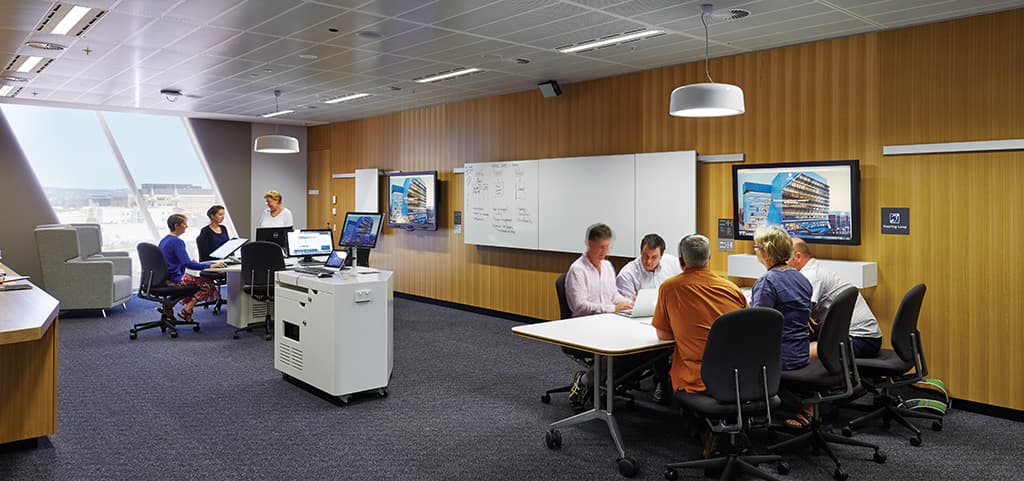
TWO TYPES OF COLLABORATION
The nine main teaching spaces in the building were all built around collaborative learning principles with two main room types.
Type 1 collaboration rooms are based around six-person rectangular tables. On the wall at the end of each table, a 46-inch monitor allows display of student BYO devices or the single PC (with USB document camera). There is a lectern, but the intent is for the academic to be able to roam freely while displaying content from a wireless tablet. The lecturer can send their own content to all screens, or choose student sourced material from any of the table screens and send that to all displays in the room. Switching duties are handled by an AMX Enova DGX matrix switcher in the head-end rack.
The Type 2 rooms feature round tables seating nine students with three resident PCs and an under-table rack with an AMX DVX all-in-one for switching and control. A 55-inch Smart touchscreen panel with Meeting Pro software is wall mounted adjacent to each table. Again, a DGX matrix distributes sources switched at each table to any or all monitors. To make things more interesting, six of the rooms were designed to be joinable with an operable wall and had to be programmed to operate either individually, or as one.
MOCK UP NOT MUCK UP
Since collaborative rooms were new to most of the teaching staff, the university made two decisions quite early in the process to ease the transition. Firstly, they prototyped the rooms by building full-sized mock-ups of the proposed collaborative tables and the lecterns. The prototypes were then demonstrated to stakeholders to gain feedback on touch panel designs and general usability. Secondly, a dedicated training room, complete with Type 1 and Type 2 student tables, was incorporated into the design of the Jeffrey Smart building. This allows teaching staff to experiment with the operation of the technology before “going live” in front of a class, and provides a handy in-house training room for general purpose use.
There’s plenty more, and one of the features of the project was the diversity of different kinds of audiovisual equipped spaces across the eight levels of the building. The smallest are two-person ‘huddle spaces’ and small project rooms equipped with a single, auto switching display; a resident PC; wall plates providing USB, power and BYOD connections; and a webcam for videoconferencing.
Stepping up, the medium- and large-project spaces feature larger displays, a cable cubby for BYOD, and add a Ladybug document camera. These rooms are controlled by an AMX button panel. Larger syndicate rooms are broadly similar but the LCD gives way to an 80-inch interactive whiteboard. These syndicated rooms also use the Extron IN1606 scaling presentation switcher, which were selected for its reliable switching capabilities.
A special feature, designed specifically for law students, is the AV Practice room. This space is laid out as a mini moot court to allow student barristers to practice their courtroom addresses. The room is fitted with a 55-inch flat panel, two AMX-controlled PTZ cameras and microphones. The configuration allows students to record their presentations (including content from the PC) directly to their own USB stick so they can review the mock trial later on.

GET A ROOM
The Jeffrey Smart Building is deliberately student-centred and so, when not in use for scheduled classes, every space, from the smallest to largest, can be booked and used (complete with AV facilities) by students. This is facilitated by a custom wayfinding system designed in-house at UniSA.
From each touchscreen kiosk, students can access the wayfinding screen (actually a web interface to the back-end system) to book a room, find a service or locate an available computer. Statistics drawn from the booking system demonstrate just how well the Jeffrey Smart building has been accepted by UniSA students. On day one, within three hours building opening, virtually all the project spaces were booked and in use by students, along with 90% of the 670 student-use PCs.
From the start, the building was designed to be a social hub for students, so along with the study spaces there is a café, kitchens for preparing snacks and even an outdoor cinema sporting a 10,000-lumen Panasonic projector with an inflatable screen, used for free night-time screenings in the courtyard.
BRUSHING UP
Finally, it would be remiss not to mention the media wall. This jewel in the Jeffrey Smart AV crown is located in the ground floor Art Gallery space and features 16 x 55-inch Mitsubishi panels front-ended by an Extron Quantum Elite media wall processor fed by another AMX Enova DGX 32-input switcher. There’s a total of 11 inputs, including a TV tuner for those all-important World Cup dates and a command PC with a 4K graphics card that regularly displays student course work from the School of Architecture in UHD.
Whew! Through a four-year gestation, prototyping cycles and a last-moment technology redesign, the Jeffrey Smart building has earned its stripes as a 2015 AVIA award winner and delivered on its promise of a student-centric set of spaces encouraging on-campus participation and providing an exceptional student and staff experience.
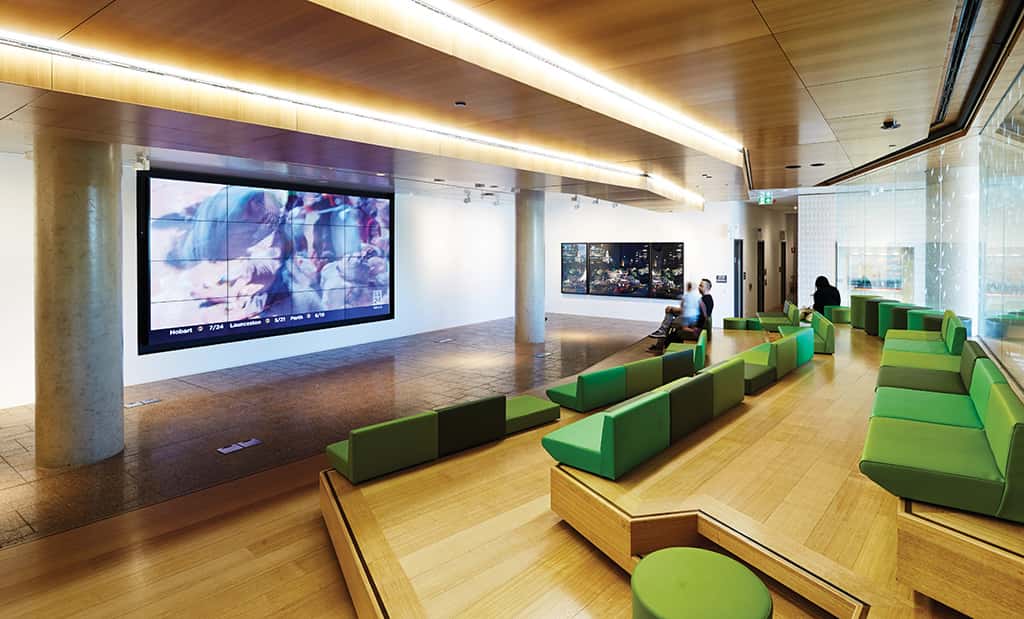
EQUIPMENT LIST
Flat Panel Displays (161 total)
Mitsubishi
Samsung
55-inch Smart Interactive Panels
70-inch Smart Interactive Panels
Projectors (16 total)
Epson EB-485W – WXGA Ultra Short Throw 3100 lumens
Epson EG-G5750WUNL – WUXGA 4500 lumens
Epson EB-8000WU – 6000 lumens
1 × Panasonic PT-DZ510XE – WUXGA 3x Chip 10000 Lumens
Smart Interactive Whiteboards (9 total)
AMX Controllers (56 total)
Netlinx NI-700
Netlinx NI-3100
Netlinx NI-4100
iPads for AV Room Control (11 total)
AV Switchers (140 total)
30 × AMX Enova DVX-3150HD switchers
5 × AMX DGX 32 enclosures
7 × AMX DGX 16 enclosures
8 × Extron IN-1606 switchers
33 × Extron SW2-HDMI switches
33 × Extron SW2-USB switches
82 × AMX DxLink HDMI extenders
77 × Extron Cable Cubbies with cable retractors
Audio
Digital Signal Processors
2 × Biamp Nexia SP
11 × Biamp AudiaFlex DSP chassis
23 × Australian Monitor 100V line amplifiers
AKG Wireless Microphones
Document Cameras
Lumens Ladybug LM-DC120 for students at most desks with AV
Ceiling-mounted Lumens LM-CL510 above lecterns and boardroom tables
The Gallery Media Wall (4×4 Video Wall)
16 × NEC 55-inch video wall display panels
Extron Quantum Elite Pro video wall processor
AMX Enova DGX 32 chassis
4K graphics PC
Multiple HDMI inputs
2 × digital signage players
2 × Blu-ray players
Biamp AudiaFlex DSP
Sennheiser IR hearing augmentation system
Australian Monitor amplifiers

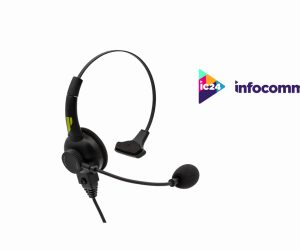
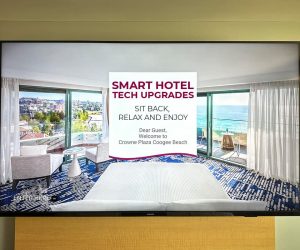
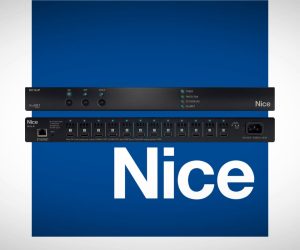
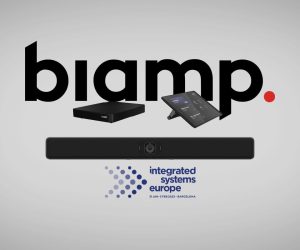

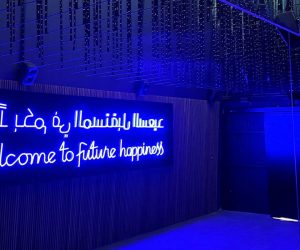


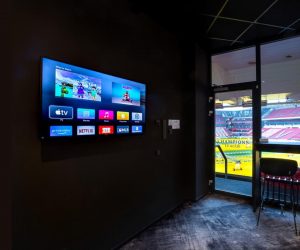





RESPONSES